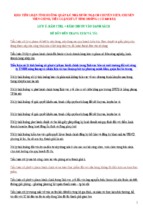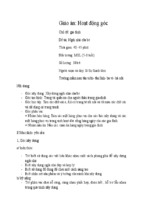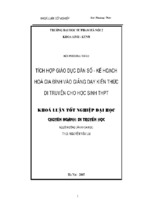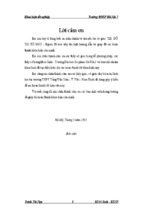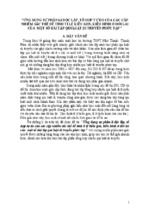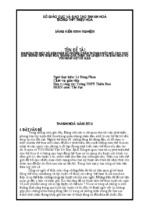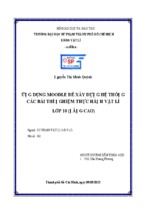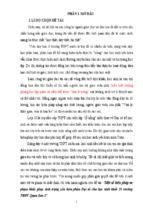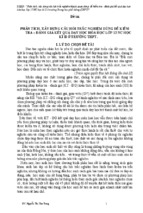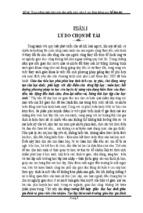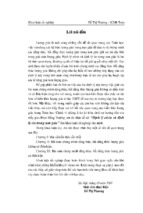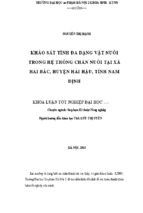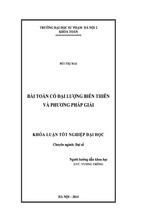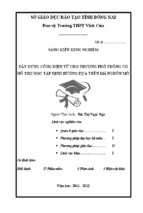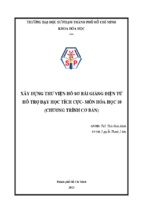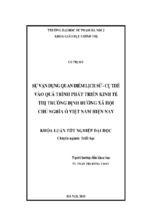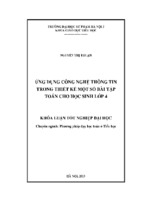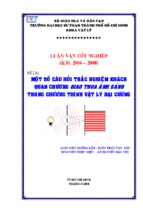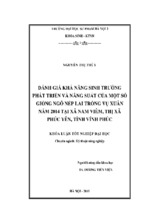HỌC HÌNH HỌC KHÔNG GIAN
QUA 15 PHÚT CỦNG CỐ
VỚI ANH NGỮ
Lời ngỏ :
Hình học không gian là 1 phân môn học toán hay. Tuy vậy , để học sinh
thích học ,chịu tìm hiểu hết chương trình là không dễ. Thực tế , tôi thấy, giờ
học nào, tạo ra được tình huống mới, có vẻ tự nhiên, không áp lực, bọn trẻ tỏ
ra rất thích học toán, và học toán giỏi, kể cả học sinh đã chọn thi khối C, D.
Hưởng ứng nhu cầu bước đầu, dạy và học toán trên Anh ngữ do nhà trường đề
ra, năm nay, tôi và các em khối 11 có phần củng cố bài hình học không gian
bằng tiếng Anh, khoảng 5_ 15 phút sau hết, ở tiết bài tập, mỗi bài học, cũng là
dịp tạo yêu cầu mới cho các em vui mà học .
Có thể chia tài liệu nầy làm 3 phần :
_ Phần 1 : Những bài toán về quan hệ song song. Bài toán đơn giản, số
lượng ít, do các em cần phải làm quen khái niệm , thuật giải của phân môn
mới , từ vựng mới.
Những bài toán về quan hệ vuông góc. Bài toán phức tạp dần,
phong phú hơn , được chuẩn bị nhiều hơn, học sinh viết tự tin hơn .
_ Phần 2 : Trình bày 1 tình huống mới trong 1 tiết học đã thực hiện.
_ Phần 3 : Một số đề bài tập tham khảo, thay đổi, cho tiết học sau.
Có 3 bài toán do học sinh tập viết trong giờ hoạt động nhóm, tôi cũng xin
đưa vào đây, ghi nhận năng lực và tính hiếu học của các em. Một số bài tập đề
nghị nữa, chủ yếu lấy từ chương trình hiện hành, mục đích chính vẫn là học
toán. Rất tiếc là thời gian có thể dành cho vấn đề còn eo hẹp. Tôi e rằng,
chúng tôi còn nhiều lỗi trong biên dịch.
Mấy lời trình bày. Kính mong quí Thầy chỉ dẫn thêm.
Giáo viên
Nguyễn Kim Thoa
Unit 1 :
PARALLEL RELATION
Problem 1 :
Given pyramid S.ABCD. M �AB, N �CD. ( ) M , ( ) // SA
a/. Find the intersections of ( ) and (SAB) and (SAC)
b/. Find the intersection of pyramid S.ABCD and ( )
c/. Find the MN’s condition in order the intersect plane of pyramid
S.ABCD and ( ) is a trapezium.
Solution
S
a. Is there any common point
of ( ) and (SAB) ?
P
_ Direction of ( ) ?
b. Means of the intersection
of pyramid and a plane ?
Q
A
D
M
R
B
N
C
a/. Find the
intersections of ( ) and (SAB)
and (SAC):
// SA
�
�
�SA �( SAB)
�M � �( SAB)
�
� �( SAB ) MP
( MP // SA)
On the analogy, call R MN �AC , we have �( SAC ) RQ // SA
b/. Find the intersection of pyramid S.ABCD and ( ) :
In turn MP,PQ,QN,NM are intersections of ( ) and (SAB),
(SBC), (SCD), (ABCD)
Thus the intersection of pyramid S.ABCD and ( ) is a
quadrangle MNPQ
c/. Find the MN’s condition in order the intersection of pyramid
S.ABCD and ( ) is a trapezium :
�
MP // QN (1)
MNPQ is a trapezium � �
MN // PQ (2)
�
(1) � SA // QN (as SA//MP)
� SA //( SCD ) ((!), as S int er sec tion po int)
(2) � MN // BC ,
�BC ( ABCD ) �( SBC )
�
as �MN �( ABCD)
�PQ �( SBC )
�
�PQ �( SBC )
(agreed)
�MN � & BC �( SBC )
Oppositely, if MN//BC then MN//PQ, as �
Thus MN//BC is the MN’s condition in order the intersection of pyramid
S.ABCD and ( ) is a trapezium.
Problem 2 :
On a plane (P), given parallelogram ABCD.
Draw the parallel rays : Ax // By // Cz // Dt ( in the same direction of (P)).
A plane ( Q ) intersects with Ax, By, Cz, Dt at A’, B’, C’, D’.
a/. Prove (Ax,By)//(Cz,Dt)
b/. Which shape is tetragon A’B’C’D’?
c/. Prove AA’ + CC’ = BB’ + DD’
C'
t
x
B'
O'
D'
A'
B
C
O
A
D
Solution:
a/. (Ax,By)//(Cz,Dt):
Ax // Cz �
�� ( Ax, By ) //(Cz, Dt )
AB // DC �
b/. The shape of tetragonal A’B’C’D’?
�A ' B ' (Q) �( Ax, By )
�
C ' D ' (Q ) �(Cz , Dt ) � A ' B '// C ' D ' (1)
�
�
( Ax, By ) //(Cz, Dt )
�
On the analogy, we also have A ' D '// B ' C ' (2)
(1)&(2) � A’B’C’D’ is a parallelogram
c/. AA’ + CC’ = BB’ + DD’ :
Put O AC �BD; O ' A'C ' �B ' D ' , then :
O is the middle point of AC , O’ is the middle point of A’C’,
so:
AA ’ + CC’ = 2OO’
On the analogy, we also have BB ’ + DD’ = 2OO’
Therefore :
AA’ + CC’ = BB’ + DD’
Problem 3 :
Given
a upyramid
S.ABC. Call I a central point of SB.
uur
uu
r
JS 2 JC , O is the centre of ∆ABC.
a/. Find the intersection of the pyramid and (OIJ).
b/. M �( ) , ( ) // (OIJ). Call BC = x ( x > 0 ).
Find x in order ( ) intersect with pyramid S.ABC.
c/. Find the intersection of the pyramid and ( ) base on x
Solution :
a/. Find the section of the pyramid and plane(OIJ) :
Call P0 the midlle point of BC.
In (SBC):
IS JS
IS JC DB
� � IJ �BC D : .
.
1 (Ménélaus)
IB JC
IB JS DC
1 DB
� (1).( ).
1 � DB 2 DC ,
2 DC
ie: C is central point of BD ( thus :
DB
4
DP0 ; BD 4 BP0 )
3
In (ABC): OD �AB L; OD �AC K
In ABP:
�
LA DB OP0
.
.
1 ( by Ménélaus theorem)
LB DP0 OA
LA 4 � 1 �
2
. .�
� 1 � LB LA (thus BA 5BL )
3
LB 3 � 2 �
In ABC:
LA KC DB
.
.
1 (by Ménélaus theorem)
LB KA DC
3 KC
.2 1 � KA 3KC
2 KA
Thus: .
Thus the section of plane (OIJ) and the pyramid is IJKL
b/. Find x in order ( ) intersect with pyramid S.ABCD :
( ) // (OIJ) or ( ) �(OIJ) � the section of ( ) and each plane of the
pyramid, if existing, must either parallel or coincide with the side of the plane
section IJKL .
M , ( ABC ) M
( ) ( ABC )
( ) �ǹ�
. The direction of the
intersection of ( ) and (ABC)is the direction of LK, not the direction
both of AB and AC, so certainly, ( ) intersect with both AB and AC.
Call the intersection of ( ) and AB, AC : N, R, the intersections of SB,
SC, SA and ( ) : P, Q, E, if existing, then :
BM
BN
x 0 then
�0, , and :
BC
BA
BN BL BA
BN BP
�0
BP BI BS
BA BS
CR CK CA
CR CQ
CR BN
�0
, moreover,
.
CQ CJ CS
CA CS
CA BA
If
Thus, if N �AB then ( ) intersect with the pyramid S.ABCD
M
S
Q
P
D
J
I
j
R
A
C
K
O
N
L
B
B�
M
As N �������
BM
BM
0 and
�0
BC
BC
BM
0 .
BC
B
�
N�
B ���M B
�
N �� A
M
�A ��� M
N
M0
M0 :
BM 0
BC
BA
BL
5
Thus, if N move on AB then M move on BM0 , ( ) intersect either BC
or AC.
Thus : ( ) intersect the pyramid � 0 x 5
c/. Confute the intersection of the pyramid and ( ) base on x
0< x < 1 � 0
BM
1 � M � BC: the plane section is MNR.
BC
x=1 M C
section is CNR
1 < x < 4 � 1
: the
BM
4 � M �CM0 and BM 0 4 BC : the section
BC
is NPQR.
Espeacially, x = 2: M �D : the section is KLIJ
x = 4: P �Q �S : the section is SNR. ( M �M 1 )
4 < x < 5 � 4
BM
5 � M � M0M1: the section is QNE
BC
S
D
J
I
A
O
P
L
N
B
K
j
M
C
M
S
T
D
J
I
A
O
R
N
K
C
L
B
Cho hình hộp ABCD. A’B’C’D’.
Tâm I: tâm bình hành
ABCD.A’B’C’D’. uuur uuuuur uur
Chứng minh: vectơ BC , B ' D ', IK
đồng phẳng
Given a parallelepiped ABCD.
A’B’C’D’. Call I centre
-
Unit 2 :
PERPENDICULAR RELATION
Program 1 :
Given a regular tetrahedron ABCD. Call M central point of BC.
Calculate the angle between 2 lines :
a/. AM and CD
b/. AB and CD
A
A
P
P
N
N
B
D
B
H
M
D
H
M
C
C
Hình a.
Hình b.
Solution :
a/. Calculate the angle between AM and CD :
Draw MN//CD then �
AMN ( AM , MN ) ( AM , CD)
AMN is isosceles at A:
1
a
MN
1
cos �
AMN 2
4
AM
3 2 3
a
2
� , CD arccos 3
Therefore : AM
6
��
AMN arccos
b/. Calculate the angle between AB and CD :
Call N,P central points of BD, AC
�
a 3
�
�� PN BD,
2
N : central po int BD �
�
PB PD
2
2
�a 3 � �a �
a2
PN PB BN �
�2 �
� � �
� � �2 � 2
� ( MP, MN ) ( AB, CD )
MP // AB; MN // CD � PMN
2
2
2
PM 2 MN 2 PN 2
�
� 900
In MPN : cos PMN
0 � PMN
2 PM .MN
3
6
Thus: (AB,CD) = 900
Problem 2 :
Given a regular prism ABC. A’B’C’ whose value of side is a, and a plane
( ) : A �( ), B ' C ( ) .
Find the intersection of prism ABC.A’B’C’ and plane ( ) .
Solution:
-ABC.A’B’C’ is a regular prism � BB ' ( ABC ) � BB ' is
perpendicular to any line in (ABC)
uur
uuur
uuur
-Call I, I’ midpoints of BC, B’C’ � II ' BB ' AA ' .
-Thus: oAA ' II ' is a rectangle and AA ' ( ABC )
oBB ' C ' C is a square
C'
A'
I'
B'
J
A
C
I
B
-AI: the height of equilateral triangle ABC with AB= a
a 3 �
�
2 �� AI ( BB ' C )
AI BB ' (as (1) ) �
�
� AI BC , AI
(*)
� AI B ' C (1)
-B’C’, C’B are diagonals of a square BCC’B’. Thus, C ' B B ' C
�IJ // C ' B � IJ B ' C (2)
�
-Call J central point of CC” : � 1
1
a 2
�IJ C ' B BC. 2
2
2
2
�
- (1) & (2) � B ' C ( AIJ ).
-
( AIJ ) �( ABC ) AI
�
�
( AIJ �( BB ' C ' C ) IJ ��VAIJ is a int er sec tion of ( ) and ABC. A ' B ' C '
( AIJ ) �( AA ' C ' C ) AJ �
�
- (*) � AI IJ � AIJ is a right-angled triangle, with a right
angled at I.
S( AJI )
1
1 a 3 a 2 a2 6
AI . AJ .
.
2
2 2
2
8
(Homework ) the 2nd answer :
Find the intersection of prism ABC.A’B’C’ and plane ( ) , known
( ) B ', ( ) A ' I .
Problem 3 :
Given a pyramid S.ABCD whose bottom ABCD is a diamond.
AB SA SB SC a
a/. Prove ( ABCD ) ( SBD )
b/. Prove SBD is an right-angled triangle
S
A
B
O
Solution:
D
H
C
a/. Prove ( ABCD) ( SBD)
Call H a intersection point of three perpendiculars of ABC
� H �BD and HA HB HC (1)
As SA SB SC � SH ( ABCD ) � SH AC
�BD AC
�
�SH AC
�SH �BD H
�
� ( SBD) AC � ( SBD) ( ABCD)
b/. Prove SBD is an right-angled triangle
O AC �BD
As AS AB, �
AOS �
AOB 1v � ABO ASO � BO SO
SO BO OD � SBD is right angled at S
Problem 5 :
Given a regular pyramid S.ABCD whose bottom of is a square.
a/. Calculate the angle between SA and (ABCD)
b/. Calculate the angle between SB and AC
Solution:
S
A
B
O
D
C
a/. Calculate the angle between SA and (ABCD)
BD �AC O � SO ( ABCD ) (as S.ABCD is a regular pyramid)
� OA
�
� ( AS , ( ABCD)) ( AS�, AO ) SAO
SAC is a right triangle with right angle O
2
OA a
2 1
�
� cos S AO
AS
2
a 2
�S�
AO 45o
Thus ( AS�
, ( ABCD )) 45o
b/. Calculate the angle between SB and AC
AC SO( as SO ( ABCD ))
AC BD( as ABCD is a square )
� AC (SBD) � AC SB � ( AC , SB ) 90o
Problem 4 :
On a plane (P), given rhombus ABCD. From 4 points A,B,C,D,
draw the rays Ax, By, Cz, Dt that all are perpendicular to ( P) and in the
same direction of (P). Plane ( Q) // BD and
Ax �(Q) A ', By �(Q) B ', Cz �(Q) C ', Dt �(Q) D '.
AC �BD O, A ' C '�B ' D ' O ',
Prove that A’B’C’D’ is a rhombus.
C'
t
x
B'
O'
D'
A'
B
C
O
A
D
Solution:
ABCD is a parallelogram , AB//CD, AD//BC.
Ax // Cz �
�� ( Ax, By ) //(Cz, Dt )
AB // DC �
�A ' B ' (Q) �( Ax, By)
�
C ' D ' (Q) �(Cz, Dt ) � A ' B '// C ' D ' (1)
�
�
( Ax, By ) //(Cz , Dt )
�
On the analogy, we also have A ' D '// B ' C ' (2)
(1)&(2) � A’B’C’D’ is a parallelogram
AA ' ( ABCD), CC ' ( ABCD) � proj( ABCD ) A ' C ' AC
On the analogy, we also have :
proj( ABCD ) B ' D ' BD
(Q) // BD � (Q) �( By, Dt ) B ' D '// BD
BD AC , BD OO ' � BD ( AC , OO ' )
A'C ' O' , A'C ' // AC � A'C ' �( AC , OO ' ) � BD A'C '
B ' D ' // BD � B ' D ' A'C '
Because A ' C ' B ' D ' , A’B’C’D’ is a rhombus .
Problem 6 :
Given a regular prism ABC.A’B’C’ whose bottom is a equilateral triangle.
Value of every side is a. D a central point of CC’.
a/. Calculate the angle between DB and A’B’
b/. Calculate the angle between (DAB) and (ABC)
A
M
D
H
C
A
M
B
Solution:
A
M
D
H
C
A
M
B
Call M the midpoint point of AB
ABD is a equilateral triangle with side a
a 3
� CM
, CM AB
2
CC ' ( ABC ), CC ' a � CD a , and :
2
CDM is right angled at C : DM 2 CD 2 CM 2 a 2 � DM a
CDA CDB � DA DB � DAB is isoceles angled at D � DM AB
DM
�
� arctan 2
.DMB is right angled at M � tan DBM
2 � MBD
MB
�
�
�
A ' B '// AB � ( A ' B ', BD) ( AB, BD) ABD arctan 2
CM AB
�
� ((C �
as �
thus : (CMD) AB at M � CMD
AB ), ( DAB ))
DM
AB
�
�
CMD is right angle at C , tan CMD
CD
1
CM
3
Problem 7 :
Given a regular prism ABC.A’B’C’ whose bottom is a equilateral triangle.
Value of every side is a. D a central point of CC’.
a/ Fine the value of the distance between A’ and (ABD)
b/. Fine the value of the distance between A’B’ and BD
A
M
D
H
C
A
M
B
Solution:
�AA ' ( ABC )
�
ABC. A ' B ' C ' is a regular prism with value of every side is a, thus �
� AA ' AB
CM a 3
�
2
�
gAB // A ' B ' � ( ABD) // A ' B ' (1)
�MM ' AB
gIn turn call M , M ' central po int s of AB, A ' B ' � �
� ( DMM ') AB
�DM AB
� ( DMM ') ( ABD) with line of int er sec tion DM .
a
CD
2
�
g Re alize : CDM is right angled at C � tan CMD
CM a 3
2
� 30 � M
�' MD 600
� CMD
0
gFrom M ' �A ' B ', draw M ' H ( ABD)
M ' H ( ABD)
(2)
(2)
, thus :
�' MD a.sin 60 0
; M ' H MM '.sin M
g(1) & (2) � d ( A ' B ', ( ABD)) d ( M ', ( ABD)) MH .
gA ' B ' and BD, as D �( ABB ')
(3)
g(1) & (3) � d ( A ' B ', bD) d ( A ' B ', ( ABD))
Problem 8 :
a
2
a
2
1
3
The base of a pyramid S.ABCD is a rhombus ABCD of side a with center O.
SO ( ABCD), SO a, �
A 600
a/. Find the distance between A and (SBC)
b/. Caculate the angle between SA and (SBC)
c/. Caculate the angle between (SAD) and (SBC)
Solution:
In ABD :
AB = AD = a ( as ABCD is rhombus)
�
A 600
�
A 600 � ABD is an equilateral triangle
� BD AB AD a
O is a central point of BD (as BD �AC O) � OB OD
BD a
2
2
In a rhombus ABCD, AC �BD O � AC BD at O
OC OB � OBC is right angle at O
a 2 3a 2
� OC BC OB a
4
4
2
Thus OC
2
2
2
a 3
4
S
A'
H
B
E
C
O
A
D
a/. Find the distance between A and (SBC)
O is a central point of AC
� d ( A, (SBC )) 2d (O, ( SBC ))
A
O
H
C
A'
( SBC )
From O, draw OE BC
SO BC ( as SO ( ABCD )) � BC ( SCE )
� ( SBC ) ( SOE )
The intersection of (SBC) and (SOE) is SE.
From O �( SOE ), draw OH SE � OH ( SOE )
� OH d (O, ( SBC ))
BOC with right angle O as a height OE
�
1
1
1
a 3
� OE
2
2
2
OE
OC
OB
4
SO ( ABCD ) � SO OE � SOE is right angled at O
SOE with right angled at O has a hieght OH:
1
1
1
1
1
2 2
2
2
2
3a
OH
SO OE
a
16
a 57
� OH
19
�
Thus d ( A, ( SBC ) 2d (O, ( SBC )) 2OH
2a 57
19
- Xem thêm -

